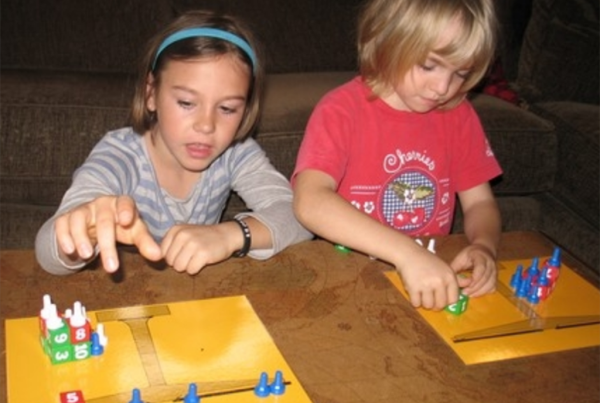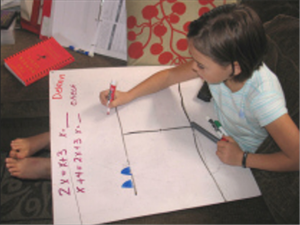
Hands-On Equations Review by Julie Brennan, Editor of LivingMath.net, June 2007
Hands-On Equations is a concrete, manipulative-based introduction to algebra that can be presented to children as young as 7. All you need to know is your basic addition/subtraction facts and to be able to learn the “rules” of legal moves you can make to solve equations. Ingenious program with wide age range applicability, see full review below. While it appears to be supplementary, it fills in so much conceptual understanding for children in the upper elementary and middle school years that is often not provided by traditional math programs and fully prepares them for Algebra I.
Highly recommended.
I received the manipulatives, the instructional DVD, the teaching materials, and work out problems that come with it. All four of my kids have used it now, it has a very wide age range of applicability.
“Because it is taught like a game, my 7 y/old could use it after she viewed the video clip of another (looks like 7 y/old) child doing the problem.“
Because it is taught like a game, my 7 y/old could use it after she viewed the video clip of another (looks like 7 y/old) child doing the problem. And how can she resist game pieces and dice :o). Typical of this child who loves to draw, she went from the game pieces to the whiteboard and demonstrated her “problem” there in just the same way a later lesson is supposed to teach her how to do this. I’ve posted some pictures of how it is played.

My 9 y/old is totally ready for this and worked quickly and effortlessly through the first 3 lessons which got her to solve problems like this:
2x + 3 + 3x = x + 11 and x + 2 + 2x = x + 10
Within one month both she and her sister have easily moved into Level 2 lessons involving the white (negative x) pawn and learning the rules of simplifying by building zero sets.
The kids solve the equations using the “legal moves” they have learned. In Level 2, you learn to do this by removing equal numbers of blue pawns representing x AND equal constant values from each side of the balance beam, so a problem like this one: 3x + 7 = 4x
is with a quick swipe of 3 pawns from each side reduced to a 7 constant on one side and one pawn / x on the other. Obviously x = 7. She checks it by skip counting by 7s: If each x/pawn is 7, then 7-14-21-28 is one side, and 7-14-21-28 is on the other. 28 equals 28, it’s in balance.
For me, this is a wonderful tool to use while both of my daughters are working on memorization of multiplication. It is showing her how she is *using* it (4 times 7 = 28 is easier than skip counting). It is game-like and fun, puzzle solving. And all you need to do it is basic arithmetic skills of addition and subtraction and the ability to learn the rules of the game. Once these are learned, you can transfer that knowledge to pencil and paper.
“My biggest surprise was the reaction of my older boys to this.”
My biggest surprise was the reaction of my older boys to this. My 11-1/2 y/old has been “almost ready” for algebra for about a year. He used Singapore for half the year and ALEKS math for the 2nd half along with a lot of living math activities. He tried some of the algebra problems that ALEKS was giving him but just didn’t understand them, and I did tell him that some teaching at this point might be a remedy worth considering, but I wasn’t going to seriously pursue that until he seemed ready.
When he saw me using the Hands-On Equations manipulatives with my daughter, he eagerly asked her to join in. I had a 2nd set of game pieces and said fine, but after a while, I realized I would need to work with him separately because he zoomed through the material in the first 4 lessons immediately once he figured out the first 2 sets of legal moves (the 2nd being the ability to subtract a constant “weight” from each side as long as they are the same amounts).
“His leap from the concrete to abstract was almost immediate, but he had needed this concrete demonstration for the abstract to stick.“
What a reaction, my goodness. He was really excited because he saw how easy algebra was once you could mentally manipulate equations the way he was doing them with the game pieces. His leap from the concrete to the abstract was almost immediate, but he had needed this concrete demonstration for the abstract to stick.
In 2 weeks we went through two-thirds of the 26 lessons, which introduced the concept of a negative x and several other legal moves to form “zero sets” – a negative x plus a positive x is a zero set. The third section, Level 3, took longer as he needed to slow down working with both negative x pieces and negative constants. I thought he understood negative numbers reasonably well, but this level has made him much more comfortable working with negative numbers. Instead of memorizing rules applied to abstract numbers, he can *see* why these work. For example, to subtract a negative, it “turns into” a positive because the only way to subtract something that isn’t there is to add a zero set – a positive and negative of the same number. When you take away the negative, you are left with the positive number only. And yes, young children can learn this with the concrete method.
The other really important aspect of this is that it teaches kids to think of a negative sign as an attribute of the number itself vs. the subtraction operation elementary math usually teaches them. This is a critical factor in algebra success, as it allows one to move the negative number around within equations without making mistakes.
One evening my oldest son (15) decided to join us as well. He took an Algebra I class last year, and he did very well with it. His biggest problem has been making careless mistakes, especially with negative numbers. After solving one or two problems with his brother, did the upcoming problems with pencil and paper the way he knew how to do them from his class and now he and his brother were in a race to get the answers, LOL. But more often than not my younger son *beat* him to the correct answer, or my 11 y/old got the correct answer when my 15 y/old was wrong. This was eye-opening to all of us and of course very encouraging to my 11 y/old. My oldest son is easygoing and was amused, saying this would have made his Algebra I life easier last year had he gone through it – he called it “amazing.”
By the time we stopped that night, just a few days after having the program, my 11 y/old was solving equations like this:
2(-x) + x + 1 = 3x + 5 (solving for x and -x) and learning how to multiply in parentheses like this: 2(-x 3) + 3(-x) = 2(-x) + 15
The (-x) represents white pawns that he first calls “stars” (drawn as an x with a negative sign running through it) until you learn the rules of negatives and positives
Look complicated for a child that’s never had algebra? These are simple when you know the rules of the “game”. He isn’t ready to solve a problem like the 2nd one yet in his head, but he has used the drawing method to do it. The materials explain how to bridge from the pieces to a drawing method before you go to the completely abstract symbolic method.
After about 6 weeks my 11-year-old is now working through the Verbal Problems program, and it is challenging, showing you strategies to solve various types of problems, and the complexity increases in this volume, including solving equations with two unknowns, with simple strategies given. Yes, he will be quite ready for formal algebra when we’re done. He can now solve many easier equations in his head, mentally grouping his xs together, reducing the xs so there are xs on one side only, and reducing the constants. He does it quicker than I can do it. Talk about a confidence builder. Shame on me for thinking he was beyond benefiting from simple concrete examples like this.
While we are going slower with the 7 and 9 y/old, I’m amazed that they are tracking together at the same levels. The difference is that the 9 y/old handles problems with larger numbers better. They won’t be tackling the Verbal Problems yet, they have years of benefit to come as we’ll pick those up later when they are ready.
“I cannot recommend this enough, I am so impressed, and I have not raved about a math program I can think of without qualification.”
I cannot recommend this enough, I am so impressed, and I have not raved about a math program I can think of without qualification. We are very eclectic in how we approach math (as this site can attest to), so math programs usually require a lot of tweaking to fit our family. This, however, only required pacing adjustments, it’s easy to adjust it to your family’s pace and needs.
About the materials. While practice problems are provide, this is not a workbook program, the heart of it is the concrete problems. The DVD video segments with the kids demonstrating are engaging to my kids to watch. Some are demonstrated by a young boy about 7, and others by an 11 y/old homeschooler (she is an adult now and her review is posted below mine). Dr. Borenson isn’t quite as engaging as the kids, but the 90 minutes of lessons are very well presented. The teaching materials do explain everything you see in the DVD, but *seeing* it done is, of course, more dynamic than trying to read how it’s done.
If you are on a budget and good at figuring things out ahead of time, and can demonstrate for your kids, you won’t need the DVD. That said, there is a very positive impact to my younger children seeing the other children present lessons, and they are willing to review the lessons and over for this reason. For older kids, it’s more of a “nice to have” element. There are video clips on the website you can view for free that can give you and your kids the confidence boost of how easy it is, the ones of the kids themselves solving especially are specially recommended.
The program uses white and blue pawns and red and green dice (the green dice are negative constants) and a laminated balance beam game sheet. You can make as many copies of the worksheets as you need within a family unit per the copyright declaration.
There are practice problems for each lesson that you can use, and my children have also made up their own problems so far with some fun results.
Julie Brennan
San Diego, CA


